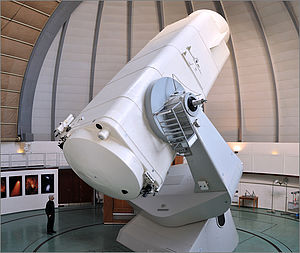TLS Telescopes and Instruments
The 2m telescope
The spherical primary mirror of the telescope has a focal length of 4m. All mirrors are made of zero-expansion glass ceramic material ("SITALL").
A TV-Guider is used for the Coudé spectrograph as well as for the guiding telescope.
The observatory is running a ZEISS 2m telescope ("Alfred-Jensch-Teleskop") which can be used in three different optical configurations:
-
The Schmidt telescope modus
The Schmidt telescope of the TLS is the largest Schmidt camera of the world. It is characterized by the following parameters:
Diameter of the primary: 2.00m Diameter of the corrector plate: 1.34m Focal length: 4.00m Field of view (unvignetted): 3.3° x 3.3° (maximum) Scale: 51.4 arcsec/mm - The Quasi-Cassegrain or Nasmyth telescope modus The Nasmyth system has a focal length of 21 meters. Because of the spherical primary, the usable field of view is only 10...20 arcsec. Using a flat mirror the light is directed through the declination axis to one of two external Nasmyth focus stations. For the spectroscopy of faint objects a spectrograph is available in the Nasmyth focus.Faint object spectrograph
- The Coudé telescope modeThe Coudé system has a focal length of 92m (f/46). The Coudé spectrograph uses a collimated beam of 150mm in diameter. Formerly, four spectrograph cameras (focal lengths: 350mm, 700mm, 1400mm, and 2800mm) and various gratings (typically 600 grooves/mm) were used providing linear dispersions from 2 to 24Å/mm. Nowadays the Coudé spectrograph is mainly used in the Echelle mode.Echelle spectrograph

The 2m Schmidt of TLS